- dot2 User Manual
- New in the Manual
- Introduction
- Intended Use
- System Requirements dot2 onPC
- Installation of dot2 onPC
- What are...
- System Colors
- Command History
- Executor
- Values
- Programmer
- Groups
- Presets
- Tracking
- Cues
- Executors
- Chasers
- Effects
- Preview and Blind
- Network
- IPv6
- DMX Tester
- System Colors
- How to...
- Turn the console on and off
- Update the console
- Add, patch, change, and delete fixtures
- Save and load your show
- Use the command line
- Use Encoders in the onPC
- Work with groups
- Work with presets
- Work with cues
- Work with chasers
- Work with effects
- Connect nodes, wings, 3D and onPC
- Use external input triggers
- Use MIDI and MIDI Show Control (MSC)
- Use the external screen
- Reset the console
- Keys
- Align
- At
- Backup
- Blind
- B.O.
- Clear
- Copy
- Cue
- Delete
- DMX
- [dot]
- Down
- Edit
- Effect
- [Encoder]
- Esc
- Exec (Executor)
- [Exec Flash]
- [Exec Go]
- Fix
- Fixture
- Flash
- Full
- Go-
- Go- (Large)
- Go+
- Go+ (Large)
- [GoFastBack] <<<
- [GoFastForward] >>>
- Goto
- Group
- Help
- Highlt (Highlight)
- Label
- If
- MA
- Macro
- Magic
- [Minus] -
- Move
- Next
- [Numeric keys]
- Off
- On
- Oops
- Page
- Page+
- Page-
- Pause
- Pause (Large)
- Please
- [Plus] +
- Preset
- Prev (Previous)
- Prvw (Preview)
- Select
- Set
- Setup
- Speed
- Store
- Thru
- Time
- Toggle
- Tools
- Up
- Update
- View [Eye]
- Views & Windows
- Control Elements
- Command Line
- Encoder Bar
- Executor Bar
- Preset Type Bar
- Title Bar
- View Bar
- Icons
- Add New Fixtures
- Backup
- Beam Preset Type
- Calculator
- Calibrate Screens
- Change Functions of Executor
- Choose Clone Method
- Choose Copy Method
- Choose Delete Method
- Choose Store Method
- Choose Update Method
- Color Preset Type
- Command Line
- Configure Slot
- Control Preset Type
- Cues
- Dimmer Preset Type
- DMX
- Edit Cue Number(s)
- Effects
- Empty Executor
- Enter Name for
- Executor Bar
- Executor Pool
- Fixtures
- Fixture Schedule Overview
- Focus Preset Type
- Gobo Preset Type
- Global Settings
- Groups
- Help
- Import Fixture Type
- Key Backlight
- Leaving Patch & Fixture Schedule...
- Load Show
- Macros Pool
- Magic Speeds
- MIDI Configuration
- MIDI Monitor
- MIDI Show Control
- Network Interface
- Network Protocols Configuration
- Network Setup
- New Show
- Off...
- Oops
- Page Pool
- Patch and Fixture Schedule
- Position Preset Type
- Presets Pools
- Remote Inputs Configuration
- Save Show As...
- Select DMX Address...
- Select DMX Ports
- Select Fixtures ID(s)
- Select Fixture Type...
- Select Function for Remote Inputs Configuration
- Select Function of Executor
- Select Language...
- Select Session Number
- Select Station...
- Select Trig
- Select Type
- Select View
- Select View for External Screen
- Select Wing...
- Session Collision
- Settings of Executor
- Setup
- Shapers Preset Type
- Software Update via USB
- Sound Input Configuration
- Status and Messages
- System Clock
- System Information
- Time defaults
- Timecode Configuration
- Tools
- Video Preset Type
- Virtual Playbacks
- Window Settings
- Wings
- Wings & Nodes Diagnosis
- Control Elements
- Commands
- >>> [GoFastForward]
- <<< [GoFastBack]
- - [Minus]
- + [Plus]
- Assign
- At
- Black
- Blind
- Call
- Clone
- Copy
- Cue
- Default
- Delay
- Delete
- Dmx
- DmxUniverse
- Edit
- Effect
- Executor
- Fade
- Fix
- Fixture
- Flash
- Full
- FullHighlight
- Go
- GoBack
- Goto
- Group
- Help
- If
- IfOutput
- Invert
- Label
- Learn
- Macro
- MidiNote
- Move
- Off
- On
- OutDelay
- OutFade
- Page
- Park
- Pause
- Preset
- PresetType
- Preview
- Rate
- Record
- Release
- Remove
- Replace
- Select
- Selection
- SetIP
- SnapPercent
- Stomp
- Store
- StoreLook
- SyncEffects
- Temp
- Thru
- Toggle
- Top
- Unpark
- Update
- View [Eye]
- Zero
- Hints for Operating
- Error Handling
- CrashLogCopy
- CrashLogDelete
- CrashLogList
- Error Messages
- Glossary
- dot2 Quick Start Guide
- dot2 3D
- dot2 Release Notes
New help version
The help version you selected belongs to an older software version. You may want to view the latest help version.
Macros Pool View
To go to the Macros Pool View on screen 1, press Macro on the console.
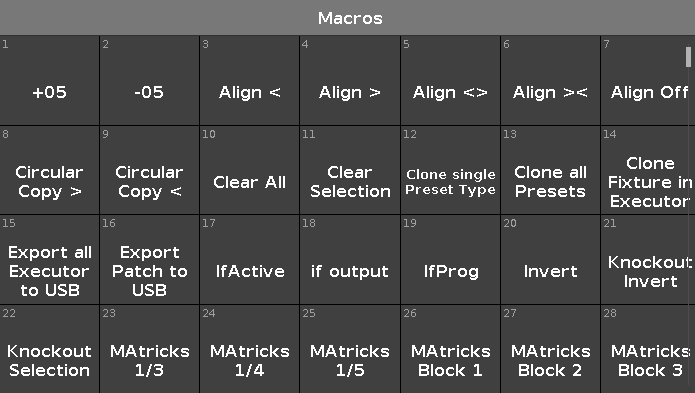
Macros are predefined, stored commands, used for automation of tasks.
They are organized in an alphabetical order.
To scroll in the macros pool view, slide the vertical scroll bar or slide up and down in the view.
There are 26 macros available:
1. +05:
Adds 5% dimmer value to the selected fixture.
2. -05:
Removes 5% dimmer value from the selected fixture.
3. Align <:
Selects the align mode <. Refer to, Align Key.
4. Align >:
Selects the align mode >. Refer to, Align Key.
5. Align <>:
Selects the align mode <>. Refer to, Align Key.
6. Align ><:
Selects the align mode ><. Refer to, Align Key.
7. Align Off:
Turns the align mode off. Refer to, Align Key.
8. Circular Copy >:
Copies all values of the selected fixtures one step to the right.
This is useful to create a chaser.


9. Circular Copy <:
Copies all values of the selected fixtures one step to the left.
This is useful to create a chaser.
10. Clear All:
Clears the selection and removes all values from the programmer. Refer to, Clear Key.
11. Clear Selection:
Clears the selection of fixtures. Refer to, Clear Key.
12. Clone single Preset Type:
Clones a single preset types from one fixture to another fixture.
Useful if you have an existing show and you get additional fixtures in the show.
Example:
Fixture 1 thru 4 uses color preset light cyan.
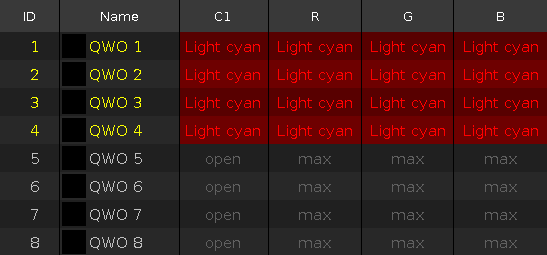
Now I got additional fixtures in the show, fixture 5 thru 8. I want that they use color preset light cyan as well.
- Tap macro Clone single Preset Type.
A pop-up asks from what fixture you like to clone. - Type 1 for fixture 1.
One of the fixtures using the preset is enough.
Tap Ok in the title bar.
A pop-up asks to what fixture you like to clone. - Type 5 thru 8.
Tap Ok in the title bar.
A pop-up asks what preset type number you like to clone. - Type 4 for color preset type.
Tap Ok in the title bar.
A pop-up informs you about how many objects will be cloned. - Tap Ok.
All the fixtures 1 thru 8 uses color preset light cyan.
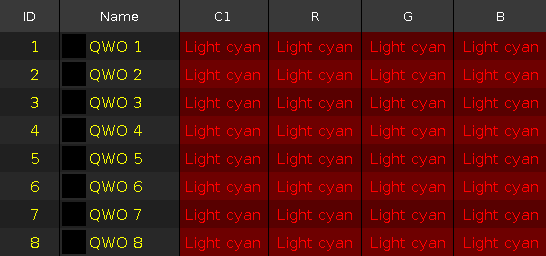
13. Clone all Presets:
Clones all presets from one fixture to another fixture.
Useful if you have an existing show and you get additional fixtures in the show.
If you clone all presets, double-check the position presets. If the fixture doesn´t have exactly the same position, you need to adjust the position presets.
Example:
Fixture 1 thru 4 were already existing. Fixture 5 thru 8 are new in the show and they should use all the same presets than fixture 1 thru 4.
- Tap macro Clone all Presets.
A pop-up asks from what fixture you like to clone. - Type 1 for fixture 1.
One of the fixtures using the preset is enough.
Tap Ok in the title bar.
A pop-up asks to what fixture you like to clone. - Type 5 thru 8.
Tap Ok in the title bar.
A pop-up informs you about how many objects will be cloned. - Tap Ok.
Fixture 5 thru 8 uses all the same presets than fixture 1.
14. Clone Fixture in Executor:
Clones the fixture only on the entered executor. If the source fixture is using a preset, the preset will be cloned as well.
This makes sense, if you need to add one more fixture on an executor what does exactly the same as another fixture.
15. Export all Executor to USB:
A shorted version of the cues view of all executors will be exported to the inserted USB stick as an .xml file. The .xml files are in the folder dot2\importexport. To open the .xml file use a browser or import the .xml file in a calculation program.
16. Export Patch to USB:
The console asks to enter the file name. Export a shorted version of the patch & fixture schedule to the inserted USB stick as an .xml file. The .xml files are in the folder dot2\importexport. To open the .xml file use a browser or import the .xml file in a calculation program.
17. IfActive:
Selects only fixtures in the fixtures view, if they have active programmer values. Refer to, What is a Programmer?
18. if output:
Selects only fixtures in the fixtures view, if they have a dimmer value bigger than 0.
19. IfProg:
Selects only fixtures in the fixtures view, if they have values in the programmer. Refer to, What is a Programmer?
20. Invert:
Enters the Invert Command in the command line.
21. Knockout Invert:
Inverts at fist the selection and removes the inverted selection from the programmer.
This is useful if you have a lot of values in the programmer but you want to store only the current selected values.
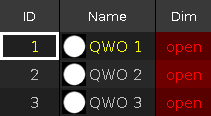
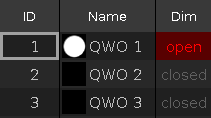
22. Knockout Selection:
Deselects the selected fixtures in the fixtures view and remove their values from the programmer.
23. MAtricks 1/3:
Selects every third fixture of the current fixture selection, starting with the first fixture.
Next and Previous Key selects the every third fixture, starting with next or previous fixture.
Example: If Highlight is on, every third fixture is highlighted.
Reset the Next and Previous Key back to default by using Macro 36 MAtricks RESET.
24. MAtricks 1/4:
Selects every fourth fixture of the current fixture selection, starting with the first fixture.
Next and Previous Key selects the every fourth fixture, starting with next or previous fixture.
Example: If Highlight is on, every fourth fixture is highlighted.
Reset the Next and Previous Key back to default by using Macro 36 MAtricks RESET.
25. MAtricks 1/5:
Selects every fifth fixture of the current fixture selection, starting with the first fixture.
Next and Previous Key selects the every fifth fixture, starting with next or previous fixture.
Example: If Highlight is on, every fifth fixture is highlighted.
Reset the Next and Previous Key back to default by using Macro 36 MAtricks RESET.
26. MAtricks Block 1:
Selects blocks of 1 fixture of the current fixture selection, starting with the first fixture.
Next and Previous Key selects the next or previous block.
Reset the Next and Previous Key back to default by using Macro 36 MAtricks RESET.
You can assign MAtricks block macros as a command in the cues view.
27. MAtricks Block 2:
Selects blocks of 2 fixtures of the current fixture selection, starting with the first fixture.
Next and Previous Key selects the next or previous block.
Reset the Next and Previous Key back to default by using Macro 36 MAtricks RESET.
28. MAtricks Block 3:
Selects blocks of 3 fixtures of the current fixture selection, starting with the first fixture.
Next and Previous Key selects the next or previous block.
Reset the Next and Previous Key back to default by using Macro 36 MAtricks RESET.
29. MAtricks Block 4:
Selects blocks of 4 fixtures of the current fixture selection, starting with the first fixture.
Next and Previous Key selects the next or previous block.
Reset the Next and Previous Key back to default by using Macro 36 MAtricks RESET.
30. MAtricks Even:
Selects every second fixture of the current fixture selection, starting with the second fixture.
Next and Previous Key function changes into a toggle function between even and odd.
Reset the Next and Previous Key back to default by using Macro 36 MAtricks RESET.
31. MAtricks Even ID:
Selects only fixtures with an even fixture ID of the current fixture selection.
Next and Previous Key selects next and previous even fixture ID.
Reset the Next and Previous Key back to default by using Macro 36 MAtricks RESET.
32. MAtricks Group 0:
To use the MAtricks Group macros, enter the values by using the calculator or the number pad.
Aligns the values across the fixture selection.
- Select the MAtricks Group and then enter the align values.

33. MAtricks Group 2:
Aligns the values across groups of 2 fixtures of the fixture selection.
- Select the MAtricks Group and then enter the align values.

34. MAtricks Group 3:
Aligns the values across groups of 3 fixtures of the fixture selection.
- Select the MAtricks Group and then enter the align values.

35. MAtricks Group 4:
Aligns the values across groups of 4 fixtures of the fixture selection.
- Select the MAtricks Group and then enter the align values.

36. MAtricks Odd:
Selects every second fixture of the current fixture selection, starting with the first fixture.
Next and Previous Key function changes into a toggle function between even and odd.
Reset the Next and Previous Key back to default by using Macro 36 MAtricks RESET.
37. MAtricks Odd ID:
Selects only fixtures with an odd fixture ID of the current fixture selection.
Next and Previous Key selects next and previous odd fixture ID.
Reset the Next and Previous Key back to default by using Macro 36 MAtricks RESET.
38. MAtricks RESET:
Resets the Next and Previous key back to their default function.
This is necessary after using MAtricks macros.
39. Off all Executor:
Turns off all executors except the main executor.
40. Off Pages Minus Current:
Turns off every page except the current visible page in the executor bar.
41. Oops Menu:
Opens the Oops View on screen 1.
42. Quicksave the Show File:
Saves the show file. Refer to, Backup Key.
43. Shuffle Selection:
The dot2 remembers the order of how you select the fixtures, e.g. from fixture 1 to 10 or from fixture 10 to 1.
This necessary for e.g. effects or the highlight function.
The shuffle selection macro mixed-up the order of the fixture selection.
Example without Shuffle Selection Macro:
Select the fixtures in the fixtures view from 1 to 8, press At 1 0 Thru 1 0 0.
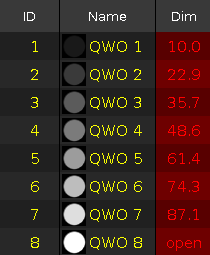
The values from 10 to 100 are assigned to the fixtures in the selection order.
Example with Shuffle Selection Macro:
Select fixtures from 1 to 8 in the fixtures view, tap at macro Shuffle Selection, press At 1 0 Thru 1 0 0.
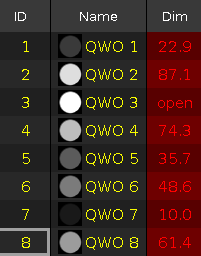
The values from 10 to 100 are assigned to the fixtures in a mixed order.
44. Shuffle Values:
Mix-up the values of the selected fixtures.


45. Stomp Running Effects:
Mutes all running effects. To start the effects again, press Clear.
For more information, see Stomp command.


